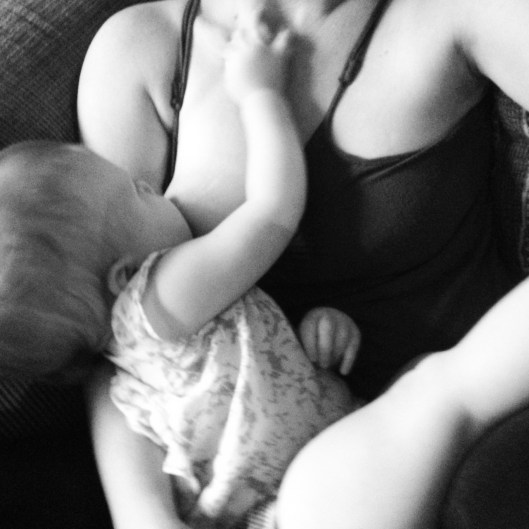by Joni Edelman

______________________
We share a bed with our babies. Actually two beds. We share two beds with our babies — because one bed just wasn’t enough bed.
I was a bed-sharer even in the early 90s when the Back to Sleep campaign was a newborn and the idea of an infant lying anywhere but a crib was gasp-worthy. How dare you risk your infant’s very life by being so foolish as to allow them to sleep in any position that deviates from flat on their back, on a FIRM mattress, without even so much as a blanket.
I ignored them.

This was before Dr. James McKenna told us, YES. Sleeping with your baby isn’t only OK it’s even good, even better. Since then Dr. McKenna has devoted his very existence (well, maybe not existence, but certainly his life’s work) to researching, writing, and talking about co-sleeping. Babies actually shouldn’t sleep alone.
I’ve put every one of my five babies in my bed, despite the finger-wagging, the “campaigns” set out to terrify me (likely in the name of crib sales), the pediatrician’s shame scowl. I did it because it matters to me, even if I get kicked in the face. A lot.
Bed-sharing is a darn good-time, and here’s how you know you’re definitely having all the fun that you can fit into one (or two) beds full of people:
- You wake up because someone kicked (or hit) you in the face. They probably didn’t do it on purpose — if it helps to know that. But it probably doesn’t help to know that because you are busy trying to sop up the blood pouring from your nose. It’s like a Game of Thrones episode — in your bed.
- You have sound, scientific evidence that your child(ren) have telepathy. They know when you’re asleep. Either that, or the sound of your deep sleep inhalation activates their Pavlovian response. “Mom is sleeping. QUICK. CRY.” (Note: This also holds in non-bed-sharing settings.)
- There is a towel in your bed, somewhere. Possibly more than one. The towel is covering pee. Because someone peed at 3 AM and no, you are not changing sheets at 3 AM. In fact, you may just leave that towel there for tomorrow when someone else pees in your bed.
- You know how to sleep with nothing but a corner of a sheet. Everyone is burrito wrapped in your blankets. You’re too tired to get up to forage for one. Sure, this 12X12 section of flimsy cotton — that probably has pee on it — will suffice. Who needs blankets anyway?
- You have mastered the art of sleeping, fetal, on the southeast 5% of the mattress. Forget that you are four times larger than your toddler. Starfish child cannot be bothered with your sleep needs.
- You can sleep without moving. AT ALL. There is a nursing baby in the crook of your arm. Because A. you know they are safe there and B. they are face-to-face with your boob. The bar is open all night.
- You’ve given up shirts. The only thing shirts are good for is absorbing milk. And, oh hey, there’s already a towel in your bed. FORWARD THINKING. Achievement unlocked.
- No fewer than 17 people have told you “if you let them sleep with you, you’ll never get them out of your bed. And for a split-second you thought, OHMYGODNO, and then you remembered that the number of 16-year-olds sleeping with their parents is practically zero.
- Your bed is on the floor and you may have more than one bed sandwiched together. This isn’t a look you’ll find in decorating magazines. You no longer care about magazines, only that everyone will just Go The F*&K To Sleep. Please. God. Sleep.
- You have slept on the floor. Because bed-sharing is beautiful, but sometimes you are so terrified to wake up your sleeping toddler by moving them, that you’ll just sleep anywhere. See: Floor.
- Your partner has slept on the sofa. No, not because you’re fighting or they don’t want to be near you. But because the baby owns you now — and also the space where daddy used to sleep. Ownership: transferred.
- Your children have never slept on the sofa. They own the bed. This is your life now. Embrace it — at least until they’re 16.
- You wake up to snuggles. And you’re reminded why the bloody nose is (probably) totally worth it.
______________________


 I’m Joni. I’m lucky enough to have 5 amazing kids (19, 16, 15, 4 and 2), one fantastic husband, an awesome sister and a yarn addiction. When I’m not raising up people I’m a freelance writer, RN, and the momma behind
I’m Joni. I’m lucky enough to have 5 amazing kids (19, 16, 15, 4 and 2), one fantastic husband, an awesome sister and a yarn addiction. When I’m not raising up people I’m a freelance writer, RN, and the momma behind 


























